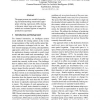NAACL
2010
13 years 9 months ago
2010
Two of the mechanisms for creating natural transitions between adjacent sentences in a text, resulting in local coherence, involve discourse relations and switches of focus of att...
INLG
2010
Springer
13 years 9 months ago
2010
Springer
The paper presents two models for producing and understanding situationally appropriate referring expressions (REs) during a discourse about large-scale space. The models are eval...
EMNLP
2010
13 years 9 months ago
2010
Several recent discourse parsers have employed fully-supervised machine learning approaches. These methods require human annotators to beforehand create an extensive training corp...
TAL
2010
Springer
13 years 9 months ago
2010
Springer
Abstract. This paper describes experiments to extract discourse relations holding between two text spans in Swedish. We considered three relation types: cause-explanation-evidence ...
CORR
2010
Springer
13 years 10 months ago
2010
Springer
We have developed a full discourse parser in the Penn Discourse Treebank (PDTB) style. Our trained parser first identifies all discourse and non-discourse relations, locates and...
IIE
2008
13 years 11 months ago
2008
Abstract. An exploratory study of students' engagement in online learning and knowledge building is presented in this paper. Learning in an online community, composed of stude...
CORR
1998
Springer
13 years 11 months ago
1998
Springer
We here explore a "fully" lexicalized Tree-Adjoining Grammar for discourse that takes the basic elements of a (monologic) discourse to be not simply clauses, but larger ...
CORR
1998
Springer
13 years 11 months ago
1998
Springer
In this paper, we present a method for identifying discourse marker usage in spontaneous speech based on machine learning. Discourse markers are denoted by special POS tags, and t...
COGSCI
2004
13 years 11 months ago
2004
This paper surveys work on applying the insights of lexicalized grammars to low-level discourse, to show the value of positing an autonomous grammar for low-level discourse in whi...
ACL
1990
14 years 18 days ago
1990
Conversation between two people is usually of MIXED-INITIATIVE, with CONTROL over the conversation being transferred from one person to another. We apply a set of rules for the tr...

